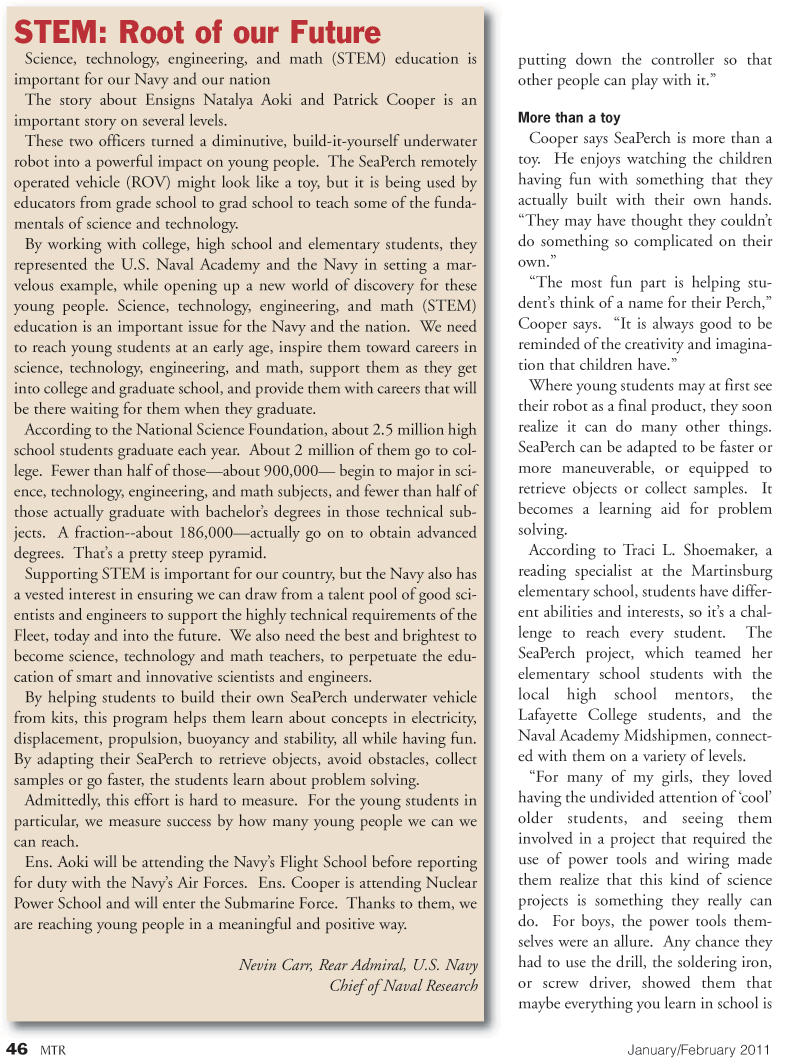
Page 46: of Marine Technology Magazine (January 2011)
Marine Salvage & Recovery
Read this page in Pdf, Flash or Html5 edition of January 2011 Marine Technology Magazine
46 MTR January/February 2011 putting down the controller so that other people can play with it.”
More than a toy
Cooper says SeaPerch is more than a toy. He enjoys watching the children having fun with something that they actually built with their own hands. “They may have thought they couldn’t do something so complicated on their own.” “The most fun part is helping stu- dent’s think of a name for their Perch,”
Cooper says. “It is always good to be reminded of the creativity and imagina- tion that children have.”
Where young students may at first see their robot as a final product, they soon realize it can do many other things.
SeaPerch can be adapted to be faster or more maneuverable, or equipped to retrieve objects or collect samples. It becomes a learning aid for problem solving.
According to Traci L. Shoemaker, a reading specialist at the Martinsburg elementary school, students have differ- ent abilities and interests, so it’s a chal- lenge to reach every student. The
SeaPerch project, which teamed her elementary school students with the local high school mentors, the
Lafayette College students, and the
Naval Academy Midshipmen, connect- ed with them on a variety of levels. “For many of my girls, they loved having the undivided attention of ‘cool’ older students, and seeing them involved in a project that required the use of power tools and wiring made them realize that this kind of science projects is something they really can do. For boys, the power tools them- selves were an allure. Any chance they had to use the drill, the soldering iron, or screw driver, showed them that maybe everything you learn in school is
STEM: Root of our Future
Science, technology, engineering, and math (STEM) education is important for our Navy and our nation
The story about Ensigns Natalya Aoki and Patrick Cooper is an important story on several levels.
These two officers turned a diminutive, build-it-yourself underwater robot into a powerful impact on young people. The SeaPerch remotely operated vehicle (ROV) might look like a toy, but it is being used by educators from grade school to grad school to teach some of the funda- mentals of science and technology.
By working with college, high school and elementary students, they represented the U.S. Naval Academy and the Navy in setting a mar- velous example, while opening up a new world of discovery for these young people. Science, technology, engineering, and math (STEM) education is an important issue for the Navy and the nation. We need to reach young students at an early age, inspire them toward careers in science, technology, engineering, and math, support them as they get into college and graduate school, and provide them with careers that will be there waiting for them when they graduate.
According to the National Science Foundation, about 2.5 million high school students graduate each year. About 2 million of them go to col- lege. Fewer than half of those—about 900,000— begin to major in sci- ence, technology, engineering, and math subjects, and fewer than half of those actually graduate with bachelor’s degrees in those technical sub- jects. A fraction--about 186,000—actually go on to obtain advanced degrees. That’s a pretty steep pyramid.
Supporting STEM is important for our country, but the Navy also has a vested interest in ensuring we can draw from a talent pool of good sci- entists and engineers to support the highly technical requirements of the
Fleet, today and into the future. We also need the best and brightest to become science, technology and math teachers, to perpetuate the edu- cation of smart and innovative scientists and engineers.
By helping students to build their own SeaPerch underwater vehicle from kits, this program helps them learn about concepts in electricity, displacement, propulsion, buoyancy and stability, all while having fun.
By adapting their SeaPerch to retrieve objects, avoid obstacles, collect samples or go faster, the students learn about problem solving.
Admittedly, this effort is hard to measure. For the young students in particular, we measure success by how many young people we can we can reach.
Ens. Aoki will be attending the Navy’s Flight School before reporting for duty with the Navy’s Air Forces. Ens. Cooper is attending Nuclear
Power School and will enter the Submarine Force. Thanks to them, we are reaching young people in a meaningful and positive way.
Nevin Carr, Rear Admiral, U.S. Navy
Chief of Naval Research

 45
45

 47
47
